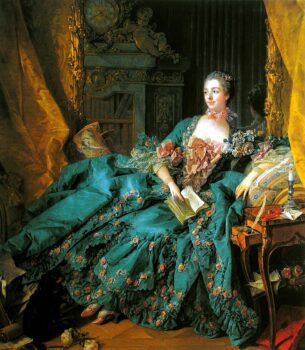The Enchanting Legacy of the Marquise: A Story of Portrait, Power, and Perception
In the hallowed halls of the Alte Pinakothek in Munich, Germany, hangs a portrait that whispers tales of beauty, intellect, power, and intrigue. The Portrait of the Marquise de Pompadour by François Boucher is more than just a painting, it is a time capsule, capturing the essence of one of the most compelling women of the 18th century: Jeanne-Antoinette Poisson, better known to history as Madame de Pompadour.
As one gazes at the painting, it becomes clear that this is no mere decorative court portrait. It’s a visual symphony of elegance and symbolism, an artistic representation of a woman who defied the limitations of her time to become one of the most influential figures at the French court.
The Artist: François Boucher, Master of the Rococo
The Portrait of the Marquise de Pompadour was painted by François Boucher, a leading figure in 18th-century French art. Boucher was the premier painter of the Rococo movement, a style characterized by its ornate detail, pastel colors, romantic subjects, and whimsical charm. He was celebrated for his ability to paint not only the aristocracy but also the mythologies, landscapes, and allegorical subjects that suited the tastes of his era.
Born in 1703, Boucher rose to prominence under the patronage of Madame de Pompadour herself. Their collaboration was both personal and political; Boucher was her favored artist, and she commissioned numerous works from him. His style, elegant, fanciful, and rich in symbolism, was perfectly suited to portray Pompadour’s complex identity as a courtesan, intellectual, artist, and political influencer.
The Portrait of the Marquise de Pompadour that resides in Munich is one of several portraits Boucher painted of her, yet this one stands out due to its intimacy and subtle grandeur.
The Subject: Who Was Madame de Pompadour?
Jeanne-Antoinette Poisson was born in Paris in 1721 into a bourgeois family. From a young age, it was prophesied by a fortune teller that she would someday become the mistress of the king. Her mother, ever ambitious, ensured Jeanne received an excellent education in literature, music, dance, and philosophy. She was groomed not just to marry well, but to shine in the court of kings.
In 1745, the prophecy came true when she captured the heart of King Louis XV of France. She was given the noble title Marquise de Pompadour, and for over two decades, she remained the king’s close confidante, advisor, and companion.
Madame de Pompadour was not a queen by birth, but in many ways, she exercised the influence of one. She controlled court appointments, influenced foreign policy, and championed the arts and Enlightenment philosophers. Her salon was frequented by figures like Voltaire and Diderot, and she used her influence to support the publication of the Encyclopédie, a cornerstone of Enlightenment thought.
The Fame: What Is Madame de Pompadour Famous For?
Madame de Pompadour is remembered as a patron of the arts, a political advisor, and a cultural icon. Her support of artists like Boucher and engravers like Jacques-Philippe Le Bas left an indelible mark on French culture. She was instrumental in advancing the decorative arts and played a key role in the promotion of the Sèvres porcelain factory, helping it become one of the most prestigious in Europe.
She was also deeply involved in architecture and interior design. Her tastes helped shape the Rococo aesthetic, influencing everything from fashion to furniture across France and beyond. Her name became synonymous with sophistication, sensuality, and wit.
But perhaps most significantly, Madame de Pompadour challenged the very notion of power and gender in her time. At a court dominated by men and tradition, she carved out a space for female influence, not through royal birth, but through charm, intellect, and persistence.
The Controversy: Why Was Madame de Pompadour Controversial?
Despite her many contributions, Madame de Pompadour was a deeply controversial figure in her time, and remains so in historical discussion.
Her role as the official chief mistress of King Louis XV placed her at the center of court gossip and public scrutiny. Many accused her of manipulating the king for personal and political gain. Some members of the aristocracy viewed her as an upstart, a commoner elevated beyond her station, and resented her influence at court.
She was also the target of satire and scorn in pamphlets known as libelles, which circulated anonymously and often portrayed her as a schemer, seductress, or even a witch. These writings reflect the gendered criticisms faced by powerful women, particularly those who wielded influence without noble birth or traditional roles.
Moreover, as the face of the monarchy’s indulgent lifestyle, she became a symbol of extravagance at a time when France’s economy was beginning to falter. Though she was far from responsible for the nation’s woes, she bore the brunt of public discontent.
The Painting: An Icon of Rococo Elegance
The Portrait of the Marquise de Pompadour by Boucher is a masterwork of the Rococo style, blending elegance, sensuality, and symbolic detail. Painted around 1756, it portrays Pompadour not just as a beauty, but as a woman of intellect and refinement.
In the painting, she is seated at a writing desk, surrounded by books, sheet music, and art supplies, symbols of her cultural pursuits and intelligence. Her dress is elaborately detailed, with layers of pastel silk, lace, and ribbon, representing the height of Rococo fashion. The background is softly lit, dreamlike, with floral motifs and decorative furniture that echo the luxurious interior designs she favored.
This is not a seductive pose meant for the king’s private chamber. It is a public image, a declaration of who she was: a patroness, a thinker, and a leader in the cultural life of France.
Unlike earlier representations of royal mistresses that focused on eroticism, Boucher’s portrayal is respectful and dignified. The painting captures not just her physical likeness, but the cultivated persona she built: a woman who belonged in salons, libraries, and theaters as much as she did in royal chambers.
Art Style: Rococo at Its Finest
The Rococo movement was born out of a reaction to the grandeur and solemnity of Baroque art. Rococo embraced playfulness, color, movement, and ornamentation. It was art for the elite, for the lovers of leisure and beauty, and it flourished in the decorative environment of the French court.
Boucher’s work epitomizes Rococo. In the Portrait of the Marquise de Pompadour, we see delicate brushwork, a soft color palette of pinks, creams, and blues, and an attention to luxurious detail that creates an almost ethereal atmosphere.
But Rococo was more than decoration, it was an aesthetic statement, an embodiment of Enlightenment ideals when viewed through the lens of the educated elite. Pompadour’s portraits reflect this duality: sensual and intellectual, frivolous and profound, fleeting and eternal.
Location Today: The Alte Pinakothek, Munich
Today, this iconic painting is housed in the Alte Pinakothek in Munich, Germany. This museum is one of the oldest galleries in the world, home to a prestigious collection of European masterpieces spanning the 14th to 18th centuries.
The fact that the Portrait of the Marquise de Pompadour found its way to Munich is itself a testament to the enduring legacy of both subject and artist. While it was created in the gilded halls of Versailles, it now resides in a museum far from France, continuing to captivate audiences with its beauty and history.
The painting stands as a jewel of the museum’s Rococo collection, drawing thousands of visitors every year who come to witness not only the artistry of Boucher but the enduring mystery of Madame de Pompadour herself.
The Legacy of a Portrait
The Portrait of the Marquise de Pompadour is more than a pretty face in an ornate frame. It is a window into a world where art and politics, beauty and intellect, power and femininity collided in complex ways. Through Boucher’s brush, we see the delicate balance Pompadour maintained: beloved companion to a king, master of courtly influence, fierce patron of culture, and target of scandal.
For centuries, this portrait has preserved her image, poised, confident, and surrounded by symbols of learning and taste. It invites viewers to consider not just who she was, but what she represented: the power of a woman who mastered the art of her own image.
In today’s world, where conversations about representation, gender, and influence are as vital as ever, Madame de Pompadour’s story resonates deeply. Her portrait reminds us that appearances can be strategic, that beauty can be armor, and that legacy is often painted in more than just one light.




